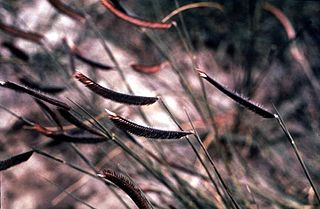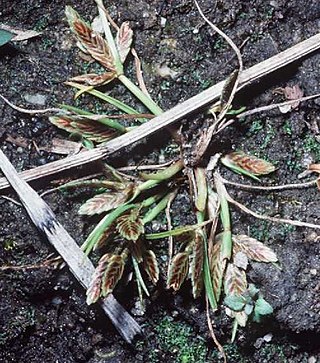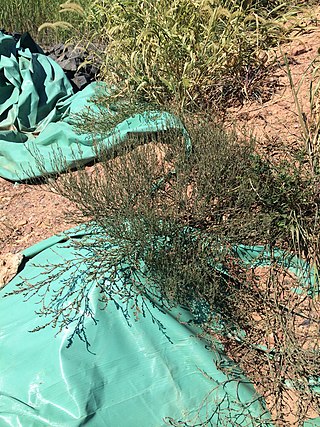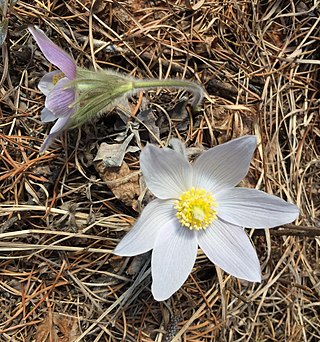
Helianthus is a genus comprising about 70 species of annual and perennial flowering plants in the daisy family Asteraceae commonly known as sunflowers. Except for three South American species, the species of Helianthus are native to North America and Central America. The best-known species is the common sunflower. This and other species, notably Jerusalem artichoke, are cultivated in temperate regions and some tropical regions, as food crops for humans, cattle, and poultry, and as ornamental plants. The species H. annuus typically grows during the summer and into early fall, with the peak growth season being mid-summer.

Maianthemum racemosum, the treacleberry, feathery false lily of the valley, false Solomon's seal, Solomon's plume or false spikenard, is a species of flowering plant native to North America. It is a common, widespread plant with numerous common names and synonyms, known from every US state except Hawaii, and from every Canadian province and territory, as well as from Mexico.

Rudbeckia laciniata, the cutleaf coneflower, is a species of flowering plant in the family Asteraceae. It is native to North America, where it is widespread in both Canada and the United States. Its natural habitat is wet sites in flood plains, along stream banks, and in moist forests. Common names other than cutleaf coneflower include cutleaf, goldenglow, green-headed coneflower, tall coneflower, sochan and thimbleweed.

Bouteloua gracilis, the blue grama, is a long-lived, warm-season (C4) perennial grass, native to North America.

Bromus hordeaceus, the soft brome, is an annual or biennial species of grass in the grass family (Poaceae). It is also known in North America as bull grass, soft cheat, and soft chess.

Rhynchospora alba, the white beak-sedge, is a plant in the sedge family, Cyperaceae. It is a tufted herbaceous perennial around 50 cm tall, with white inflorescences that flower in August. The fruit of the sedge is a small achene with a characteristic beak-like cap. It is dispersed by wind or falls by gravity, leading to individuals existing in tight clumps. The species favours wet, acidic and nutrient poor soils, thriving in Sphagnum-dominated bogs, but also peaty grasslands. As such it is often used as a positive indicator for bog and mire ecosystem health.

Cyperus acuminatus is a common species of sedge known by several common names, including tapertip flatsedge and pale umbrella-sedge. This plant is native to North America, where it is widespread across the Great Plains and the western United States, with scattered populations in the eastern US as well as in Saskatchewan, Tamaulipas and Coahuila.

Cyperus bipartitus, commonly known as slender flatsedge, river cyperus, or the shining flatsedge, is a common species of sedge. The name "slender flatsedge" also applies to Cyperus gracilis.

Cyperus erythrorhizos is a species of sedge known by the common names red-rooted flatsedge or redroot flatsedge. It is found across much of North America from Maine, Ontario and British Columbia south to Tabasco in southern Mexico.

Cyperus fuscus is a species of sedge known by the common name brown galingale, or brown flatsedge. This plant is native to much of Europe, Asia and North Africa from England, Portugal and Morocco east to China and Thailand. It is an introduced species in North America, where it is naturalized in widely scattered locations in the United States and Canada.
Cyperus niger is a species of sedge known by the common name black flatsedge. This plant is native to the Americas, where it can be found in wet areas from South and Central America to the southwestern United States, from California and Oklahoma south to Argentina.

Cyperus odoratus is a species of sedge known by the common names fragrant flatsedge and rusty flatsedge. This plant can be found in much of the tropical and warm temperate world, including South, Central, and North America, Southeast Asia, some Pacific Islands, Australia, New Guinea, Madagascar, and central Africa. It is a plant of wet, muddy areas, including disturbed and altered sites. This species is quite variable and may in fact be more than one species included under one name. In general this is an annual plant approaching half a meter in height on average but known to grow much taller. It usually has some long, thin leaves around the base. The inflorescence is made up of one to several cylindrical spikes attached at a common point. Each of the spikes bears a large number of flat, oval-shaped spikelets. Each spikelet is usually light brown to reddish-brown and has a few to over 20 flowers. Each flower is covered by a tough, flat bract with a visible midvein. The fruit is a flat achene less than two millimeters long.

Eatonella is a North American genus of plants in the family Asteraceae containing the single known species Eatonella nivea, which is called by the common name white false tickhead. This small annual is native to the western United States, particularly the Great Basin, where it grows in sandy soils. It has been found in Washington, Oregon, Idaho, Nevada, and eastern California.

Echinops sphaerocephalus, known by the common names glandular globe-thistle, great globe-thistle or pale globe-thistle, is a Eurasian species of globe-thistle belonging to the tribe Cardueae within the family Asteraceae.

Polygonum ramosissimum is a North American species of herbaceous annual plants in the buckwheat family, widespread across much of Canada and the United States, where it is commonly called bushy knotweed. It is susceptible to downy mildew caused by the oomycete species Peronospora americana.

Antennaria luzuloides is a North American species of flowering plant in the family Asteraceae known by the common name rush pussytoes. The species is native to western Canada and the western United States.

Crepis occidentalis is a North American species of flowering plant in the family Asteraceae known by the common names western hawksbeard, or largeflower hawksbeard. It is native to western Canada and the western United States.

Pulsatilla nuttalliana, known as American pasqueflower, prairie pasqueflower, prairie crocus, or simply pasqueflower, is a flowering plant native to much of North America, from the western side of Lake Michigan, to northern Canada in the Northwest Territories, south to New Mexico in the southwestern United States. Pasqueflower is the provincial flower of Manitoba and the state flower of South Dakota.
Schoenoplectus etuberculatus, common name Canby's bulrush, is a plant species native to the United States. It is reported from every state on the Gulf and Atlantic coasts from eastern Texas to Delaware, plus isolated populations in Rhode Island and Missouri. It is an emergent plant growing in ponds, marshes, stream banks, etc., including in brackish water along the coast.

Carex davisii, known as Davis' sedge or awned graceful sedge, is a species of Carex native to North America. It is listed as an endangered, threatened, or species of concern across much of edge of its range. It was named in the 1820s by Lewis David de Schweinitz and John Torrey in honor of Emerson Davis (1798–1866), a Massachusetts educator and "enthusiastic student of the genus" Carex.


















